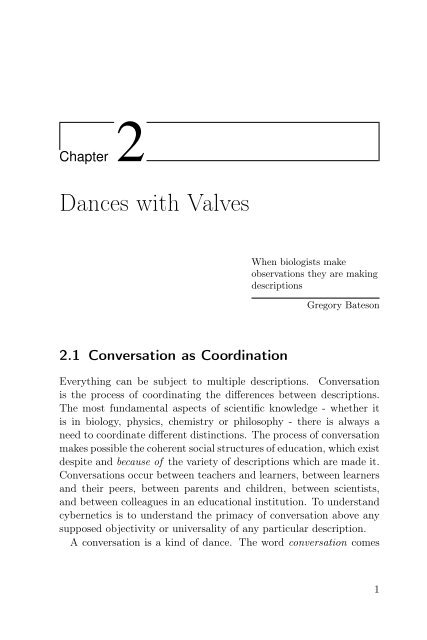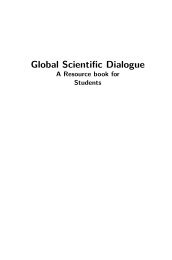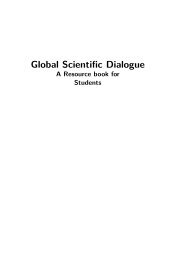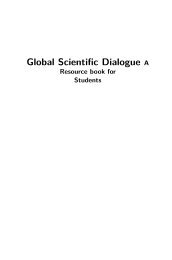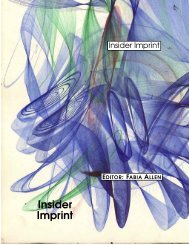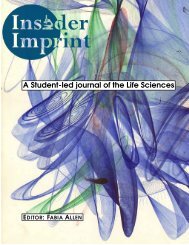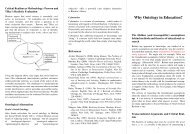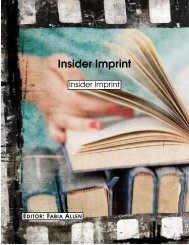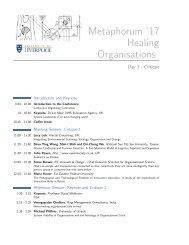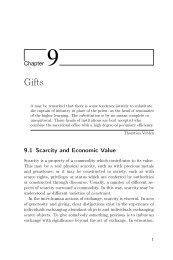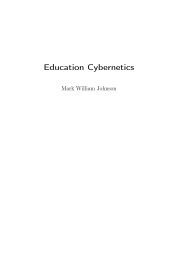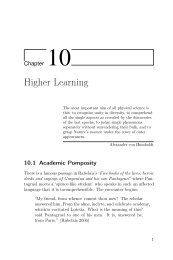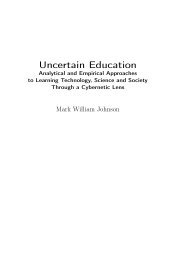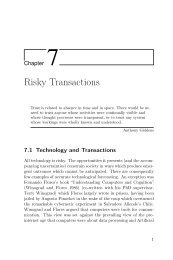education-cybernetics-ch2
You also want an ePaper? Increase the reach of your titles
YUMPU automatically turns print PDFs into web optimized ePapers that Google loves.
Chapter 2<br />
Dances with Valves<br />
When biologists make<br />
observations they are making<br />
descriptions<br />
Gregory Bateson<br />
2.1 Conversation as Coordination<br />
Everything can be subject to multiple descriptions. Conversation<br />
is the process of coordinating the differences between descriptions.<br />
The most fundamental aspects of scientific knowledge - whether it<br />
is in biology, physics, chemistry or philosophy - there is always a<br />
need to coordinate different distinctions. The process of conversation<br />
makes possible the coherent social structures of <strong>education</strong>, which exist<br />
despite and because of the variety of descriptions which are made it.<br />
Conversations occur between teachers and learners, between learners<br />
and their peers, between parents and children, between scientists,<br />
and between colleagues in an <strong>education</strong>al institution. To understand<br />
<strong>cybernetics</strong> is to understand the primacy of conversation above any<br />
supposed objectivity or universality of any particular description.<br />
A conversation is a kind of dance. The word conversation comes<br />
1
2 Dances with Valves<br />
from the Latin, con-versare. It means, “to turn together”. Two people<br />
can dance and intuitively understand the moves of the other. Equally,<br />
dancing can be awkward, or occasionally break down. Conversations<br />
are much like this. The distinctions between the things that happen<br />
in the ‘successful’ dance and what happens in the ‘awkward’ dance<br />
are subtle. Many signals about the wishes of each person are communicated<br />
through movements of the legs, hands, eyes, the coordination<br />
with the music, and the sense of physical contact. Each of these<br />
presents sets of distinctions, and many different distinctions co-exist<br />
at any time. If the dance partner is unable to read these, or react<br />
appropriately, then of course things will break down. But if things<br />
do break down, then the more expert dancer is likely to simplify the<br />
moves, to reduce the number of distinctions they make so that their<br />
partner might have a chance to response to something less complex.<br />
Both the complexity of multiple distinctions in dancing, and the<br />
shifting down from a complex dance to a simple one are aspects of<br />
conversation. What happens in the ‘shifting down’ is a recalibration<br />
of the moves that the dancer makes. Learning conversations are<br />
precisely like this. Few learning conversations begin with expert coordination<br />
between teacher and learner. There are always processes<br />
of recalibration as the teacher recognises the need to simply their own<br />
complexity so as to maintain an effective dialogue with the learner.<br />
So we begin with three important concepts:<br />
• In conversation, we exchange multiple descriptions of the world<br />
which are often presented simultaneously<br />
• Conversation is a process of coordination of the differences between<br />
different descriptions<br />
• Conversation involves a process of recalibration as one or the<br />
other party changes the level of complexity in their moves (or<br />
utterances).<br />
2
2.2 Technology and Conversation<br />
2.2 Technology and Conversation<br />
The capability of the World-Wide Web to coordinate conversations<br />
online, bypassing the constraints of time and co-location, was one<br />
of the most exciting transformative ideas for <strong>education</strong>al technologists.<br />
With what seemed to be the escape from the bounds of the<br />
classroom and timetable, new possibilities for organising <strong>education</strong><br />
present themselves. If conversations could be coordinated technologically,<br />
could, for example, the institutionally-framed constraints of<br />
curriculum similarly be transcended? Might there be new ways of<br />
dealing with assessment and certification or the social status that is<br />
accorded by the <strong>education</strong> system?<br />
In the years that have passed since the advent of online forums,<br />
Wikis, Virtual Learning Environments and social media, many of<br />
these questions are still being asked. Yet, as many writers on <strong>education</strong>al<br />
technology acknowledge, the transformation hasn’t been quite<br />
what many hoped for. Diana Laurillard, for example, comments that:<br />
“The promise of learning technologies is that they appear<br />
to provide what the theorists are calling for. Because<br />
they are interactive, communicative, user-controlled technologies,<br />
they fit well with the requirement for socialconstructisit,<br />
active learning. They have had little critique<br />
from <strong>education</strong>al design theorists. On the other<br />
hand, the empirical work on what is actually happening<br />
in <strong>education</strong> now that technology is widespread has shown<br />
that the reality falls far short of the promise.” (Laurillard<br />
2012)<br />
Radical champions of “Personal Learning Environments” - including<br />
me (Johnson 2016; Wilson et al. 2009) once argued that the technology<br />
could challenge the institutional structures of <strong>education</strong>, and<br />
that with rising costs and student fees, environmental threats and<br />
increasing demands for flexibility, students would exploit learning resources<br />
freely available on the web, and desert the campus. That this<br />
hasn’t happened raises questions about the theories about conversation,<br />
communication and dialogue, social structures and economics.<br />
3
2 Dances with Valves<br />
2.3 Conversation and Teach-back: Beyond<br />
‘Message exchange’<br />
The dance metaphor of conversation goes some way to explaining<br />
the difficulties of online communication. A dance does not involve<br />
‘exchange’ of messages in the way that is often conceived in the literature<br />
about conversation in <strong>education</strong>. The classic example is Laurillard’s<br />
conversation model (Laurillard 2001). In Laurillard’s model<br />
of teaching and learning processes, which she adapted from a more<br />
sophisticated (but extremely dense) cybernetic conversation theory<br />
of Gordon Pask (Pask 1975), there is an emphasis on the exchange of<br />
messages between the teacher to the student of what is to be taught,<br />
or what action to take, and the messages from the student to the<br />
teacher as to what is understood. Typically, the conversation framework<br />
is presented as a state-transition diagram:<br />
Teacher<br />
Learner<br />
Teacher’s Environment<br />
Learner’s Environment<br />
The model is presented as one which is driven by a comparison<br />
between the teacher’s messages and the student’s. Understanding<br />
is said to be achieved when the student articulates an explanation<br />
which conforms to what they have been taught. This was an attractive<br />
proposition to those who sought to defend text-based online<br />
utterances as being functionally-equivalent to face-to-face discussion.<br />
It overlooked, however, the complexities of conversation, of which<br />
which Pask considered in more detail.<br />
Pask introduces his original idea of teach-back in the following way:<br />
4
2.3 Conversation and Teach-back: Beyond ‘Message exchange’<br />
Teachback goes as follows: the teacher says of the student<br />
(or subject) that the student understands a topic<br />
to the extent that he can teach it back to the teacher.<br />
This is, understanding is inferred if the student can furnish<br />
an explanation of the previously discussed topic and<br />
can also explain why he gave that explanation of how he<br />
constructed it. The crucial point is that the students explanation<br />
and the teachers explanation need not be, and<br />
usually are not, identical. The student invents an explanation<br />
of his own and justifies it by an explanation of how<br />
he arrived at it (in fact an identical explanation is generally<br />
rejected unless the student can give a reason why the<br />
teachers explanation was particularly good).<br />
The difference between the teacher’s utterances and the student’s<br />
is critical in the teachback process. Pask goes on to say:<br />
It can be argued that although retention of taught-back<br />
items will be perfect within one session (it is), the resilience<br />
of a memory will depend upon the number of<br />
explanations produced in teachback; for example, that<br />
a student impelled to give many explanations will fare<br />
better at session 2 than a student required to give only<br />
one. He has many ways of reconstructing a concept and<br />
this redundancy will combat the effect of interfering and<br />
incompatible learning experiences during the intervening<br />
week.<br />
In other words, there is an overlap in the things which are described<br />
by the different explanations that a student might produce.<br />
There is a similar overlap in the explanations which a teacher might<br />
produce, and there is an overlap between the explanations produced<br />
by the teacher and the explanations produced by the learner: this<br />
overlap is what Pask refers to as redundancy: multiple descriptions<br />
of the same thing. In more recent work on <strong>cybernetics</strong> and the production<br />
of meaning, this overlap or redundancy has been studied and<br />
is widely considered to be one of the central systemic features for the<br />
5
2 Dances with Valves<br />
establishment of meaning (Leydesdorff and Ivanova 2014). Redundancy<br />
is a way of generating shared meanings in the communications<br />
between people, and behind this lies the essence of what is meant by<br />
understanding.<br />
If this is correct, then the capacity of the medium to express a<br />
variety of different kinds of explanation for things is an important<br />
factor. In most thinking about the role of technology in <strong>education</strong>,<br />
the capacity of the medium is often considered to be neutral. If<br />
the context within which the exchange between the teacher and the<br />
learner is constrained to limited forms of articulation (for example,<br />
and most commonly, text only in email or forums), then the scope<br />
for the creative expression of what Pask calls the ‘redundancy’ of<br />
explanations is equally limited. This is not to say that a variety of<br />
description within a restricted medium isn’t possible, but that the<br />
nature of the ‘richness’ of alternative descriptions is constrained to<br />
what happens in successive text messages.<br />
In face-to-face communication, or indeed, in communication over<br />
video, there are multiple descriptions of understanding expressed simultaneously.<br />
For example, somebody might explain their understanding<br />
with gestures and the movement of props in front of them<br />
(for example, in explaining Newton’s Laws of Motion). Simultaneously<br />
to moving their arms, they will give a commentary of what they<br />
mean, whilst also modulating the tone of their voice to convey the<br />
important points. The redundancy in such simultaneous communication<br />
can be seen if we were to see whether the meaning of what is<br />
conveyed could still be conveyed if any one of these different forms<br />
of communication (gestures, words, pitch of voice) was removed. In<br />
most cases, it can - although the resulting communication may be less<br />
compelling. This raises the question as to what happens in communication<br />
between these different simultaneous forms of explanation.<br />
In this process of conveying simultaneous forms of communication<br />
in conversation, the redundancy between the difference messages and<br />
different explanations suggests that there is a coordination of constraint:<br />
both teacher and learner uncover the constraints of the other<br />
by reading into the redundancies of description that each presents<br />
to the other. By understanding these constraints, future utterances,<br />
6
2.3 Conversation and Teach-back: Beyond ‘Message exchange’<br />
recalibrations and suggestions for activity are steered. A dance becomes<br />
possible because the constraints become more explicit.<br />
Now we can respond to the question, “How does the medium of<br />
communication matter?”:<br />
• Different levels of redundancy of description can be presented<br />
in different media.<br />
• The coordination of conversation can be effectively steered with<br />
the expression by both teachers and learners of different kinds<br />
of media.<br />
Those media which convey the richest degree of redundancy of<br />
communication present the easiest starting point for analysis. They<br />
also, of course, present the most compelling case for the power of<br />
technology in <strong>education</strong>. Every online course today uses videos and<br />
animations, and many exploit visualisations, simulations, and games.<br />
Equally, in the synchronous online conversations between individuals<br />
using Skype or even telephone, the simultaneous description of the<br />
voice, with its pitch, accent, tempo, combined with images over a<br />
shared period of time presents an experience which approaches the<br />
veracity of face-to-face discussion - with the benefit that these interactions<br />
can be recorded and replayed. All of these forms of media<br />
convey rich descriptions about themselves. Through the shifting<br />
lights on the screen, sounds and opportunities for interaction,<br />
multiple redundant descriptions are presented. By comparison, textonly<br />
communications which Laurillard largely concerns herself offer<br />
fewer simultaneous descriptions, which from an analytical perspective<br />
present more complexity because the text medium is so restricted in<br />
the number of ways in which learners and teachers can articulate<br />
their understanding. For this reason, we begin in this chapter with<br />
an analysis of video. In the next chapter I turn to an analysis of<br />
text - and in particular, examine the significance of social media in<br />
learning.<br />
7
2 Dances with Valves<br />
2.4 Analysing Educational Video<br />
The ability to capture and share the moving image in real-time has<br />
transformed the way <strong>education</strong> is organised. From Khan academy to<br />
the ‘flipping’ of classrooms, the easy means by which video can be<br />
produced has meant that for most <strong>education</strong>al technologists, the making<br />
of animated content in various ways has become a foundational<br />
professional skill. With the readily-available smartphone, however,<br />
it is not just professional <strong>education</strong>al technologists who can make<br />
video: the smartphone has enabled learners, just as all private citizens,<br />
to become video producers and sometimes broadcasters, able to<br />
share experiences, or broadcast events, evidence of acts of injustice,<br />
violence, protest, or capturing moments of life in a richly descriptive<br />
way. Equally, of course, personal technology has enabled individuals<br />
to broadcast video of murder, abuse, exploitation, sex and suicide.<br />
For whatever purpose it is used for, video is imbued with veracity<br />
- trusted as an accurate record of the passing of events. Video is a<br />
medium which easily documents informal and spontaneous communication<br />
and behaviour in ways which would otherwise require linguistic<br />
dexterity beyond the reach of most. It has levelled the playing field<br />
of testimony.<br />
Whilst its lens is restricted to what can make a difference to somebody<br />
staring at a screen, it nevertheless reveals aspects of human<br />
behaviour and (when applied in <strong>education</strong>) something about the ancient<br />
practices of <strong>education</strong> which become available for objective inspection.<br />
As a way of introducing some cybernetic concepts, we start<br />
by exploring an analysis of a simple video. In the process, we can<br />
introduce some powerful free or Open Source tools. Just as the technology<br />
for producing video is powerful (and much of it is free or open<br />
source), so too is the technology by which we might analyse it. In<br />
the following analysis I use three tools: Kinovea for video analysis,<br />
YouTube for text transcription, and PureData for the analysis of<br />
pitch. Other tools could, of course, be substituted for these, but the<br />
point to make is that much powerful software is available for free.<br />
The following analysis considers the information content of a video<br />
from a number of different perspectives: changes to the image; changes<br />
8
2.4 Analysing Educational Video<br />
in the pitch of the voice; the pattern of words used. By information<br />
content I mean a way of describing the complexity of different aspects<br />
of a video. It is one of the central propositions of <strong>cybernetics</strong> that<br />
complexity can be counted. Whilst the information theory equations<br />
look forbidding (at first sight), essentially all they are doing is counting.<br />
Moreover, what is counted are differences - or perhaps more<br />
explicitly, surprises. A surprise, after all, is a difference that makes a<br />
difference.<br />
2.4.1 Multiple Descriptions<br />
Edgar Morin on the cinema<br />
The multiple descriptions presented by the moving image has long<br />
been a focus for the analysis of cinema. One of the most perceptive<br />
commentators on this is Edgar Morin (who also wrote about <strong>education</strong>).<br />
In his book "Cinema and the imaginary man", Morin details<br />
the different descriptions that the cinema presents, making a comparison<br />
between the descriptions presented by the crude early medium<br />
of the animated image, and the later medium of the cinema.<br />
With such a list of different descriptions, it is interesting to consider<br />
to what extent Morin’s descriptions depend on each other. The most<br />
obvious example is to point out that the distinctions between light<br />
and shadow is complementary. Equally, the distinction between the<br />
moving camera and the succession of shots may also suggest a codependence<br />
between the distinctions.<br />
⎧<br />
Image<br />
Affective excitation established<br />
by the ani-<br />
⎪⎨<br />
mated photograph<br />
⎪⎩<br />
Shadow − reflection − double<br />
W orld within arm ′ s reach<br />
Real movement<br />
Imaginary<br />
9
2 Dances with Valves<br />
⎧<br />
Affective excitation established<br />
⎪⎨<br />
by cinema<br />
techniques<br />
Camera mobility<br />
Succession of shots<br />
Persecution of the moving element<br />
Acceleration<br />
Rhythms, tempos and music<br />
Assimilation of a milieu<br />
Encirclements<br />
Slow down and suppression of time<br />
Close-up<br />
{<br />
lighting<br />
lights<br />
{<br />
shadows<br />
high-angle shot<br />
⎪⎩ shooting<br />
low-angle shot<br />
But when might we stop? Even a static Powerpoint page with an<br />
image on it can be subject to many different descriptions of itself.<br />
Do these descriptions all amount to the same thing? What is it that<br />
adding descriptions contributes to understanding? Video presents<br />
many overlayed descriptions of a thing. There is text, moving images,<br />
pictures, words and speech. How meaning is conveyed through the<br />
interaction of these different elements has been the subject of study<br />
in cinema ever since its invention.<br />
Ezra Pound on Poetry and Chinese Ideograms<br />
When considering the ways in which a poem communicates, Ezra<br />
Pound points out a similar overlaying of factors in Chinese writing.<br />
Pound argues that:<br />
“In tables showing primitive Chinese characters in one column<br />
and the present ‘conventionalized’ signs in another,<br />
anyone can see how the ideogram for man or tree or sunrise<br />
developed, or ‘was simplified from’, or was reduced to<br />
the essentials of the first picture of man, tree or sunrise.<br />
10
2.4 Analysing Educational Video<br />
Symbol<br />
Meaning<br />
= Man<br />
= Sun<br />
= Tree<br />
= sun tangled in the tree’s branches, as at sunrise,<br />
meaning now, the East”<br />
(Pound and Dirda 2011)<br />
With the kind of overlaying of descriptions that Pound describes<br />
in Chinese writing, he explains how it is that words are assembled<br />
from other words. To define ‘red’, for example, Pound asks<br />
“How can he do it in a picture that isn’t painted in red<br />
paint? He puts (or his ancestor put) together the abbreviated<br />
pictures of<br />
ROSE<br />
IRON RUST<br />
CHERRY<br />
FLAMINGO<br />
That, you see, is very much the kind of thing a biologist<br />
does (in a very much more complicated way) when he gets<br />
together a few hundred or thousand slides, and picks out<br />
what is necessary for his general statement. Something<br />
that fits the case, that applies in all of the cases.”<br />
So what about other forms of communication? In music, for example,<br />
‘descriptions’ are overlaid on top of one another in what is called<br />
‘counterpoint’, of which J.S. Bach provides the supreme example:<br />
At the very simplest level, the combination of the two lines of<br />
music, each of which is a coherent melody in its own right, describes<br />
a sense of harmony and dynamic drive which each melody on its own<br />
11
2 Dances with Valves<br />
cannot convey. At the same time, each individual melody essentially<br />
describes very similar patterns: there is a alternation between fast<br />
and slow notes, between rising patterns and falling patterns. In each<br />
individual melody, there is an alternation between things which are<br />
expected and things which are surprising. The balance between what<br />
is expected and what is surprising is mirrored in each line of melody:<br />
each might be regarded as an alternative description of the same<br />
thing.<br />
The metaphor of counterpoint provides a way of examining video.<br />
In video, the counterpoint is between the images which are presented<br />
to the viewer, the words that are spoken, the tone of the voice that<br />
is speaking, the speech rhythm, the pace of different shots, the movement<br />
of the camera, and so on. There is, of course, often additionally<br />
music. In analysing the video’s counterpoint like this, we can examine<br />
each of these elements - the text, the pitch, the image. . The<br />
experience of watching a video, just like the experience of listening<br />
music, is one of being emotionally engaged as the different elements<br />
of surprise overlap one another.<br />
We begin by analysing a very short video which introduces the<br />
concept of ‘<strong>education</strong>al <strong>cybernetics</strong>’. The video uses animations as<br />
pictures are drawn on the screen whilst somebody talks. We are going<br />
to explore the changes to the image, the text spoken and the pitch<br />
of the voice. From a practical perspective, with this kind of analysis,<br />
each of these different elements require different tools to capture<br />
and analyse them. One of the wonders of the modern technological<br />
environment is that most of the highly sophisticated tools required<br />
for performing sophisticated analyses are available for free or as open<br />
source.<br />
To use open source tools, the analysis of the moving image requires<br />
a tool to label the different moments in the video and export the data.<br />
The open-source tool Kinovea (http://www.kinovea.org) enables this<br />
and exports a simple spreadsheet containing a time code (seconds<br />
into the video) with the description of what is happening at that<br />
time.<br />
12
2.5 Encoding surprise in the moving image<br />
2.5 Encoding surprise in the moving image<br />
Kinovea provides a simple way in which transformations in the moving<br />
image can be encoded. It is a manual process (although it is not<br />
impossible for automatic coding of changes to be achieved), and since<br />
this is the case, there is an element of subjectivity in terms of what<br />
is considered to be significant and what is not. However, this subjectivity<br />
should be seen from the perspective from which we opened this<br />
chapter: every identification of a feature, in whatever way, is one of<br />
many possible descriptions. The point of the following analysis is to<br />
see how multiple subjective descriptions relate to one another.<br />
From a practical perspective, a code can be devised to identify<br />
significant events in the video. In this example, the following code is<br />
used:<br />
Code<br />
A<br />
F<br />
S<br />
X<br />
P<br />
T<br />
Meaning<br />
Change of camera angle<br />
Draw letter<br />
Draw Spiral<br />
Zoom in<br />
Zoom out<br />
New shot<br />
By going through each second of the video, codes can be assigned<br />
to the events at different times. Kinovea will export this code as a<br />
spreadsheet of time against code which looks a bit like this:<br />
Time Code<br />
0.3 A<br />
1.0 F<br />
1.3 F<br />
1.5 F<br />
2.2 F<br />
3.1 ...<br />
This basic format of encoding media into a time-code plus an event<br />
code is the basic template into which other descriptions of the video<br />
will be produced.<br />
13
2 Dances with Valves<br />
Encoding surprise in the Spoken text<br />
Another dimension of the video are the words that are spoken as<br />
the image changes. Modern technologies for the automatic transcription<br />
of the spoken work work by analysing waveforms and rapidly<br />
matching them to a textual equivalent. The technology is embedded<br />
in many online services, including YouTube. Any video uploaded<br />
to YouTube will quickly acquire an automatically-generated caption<br />
file. This is often surprisingly accurate, and any mistakes can be<br />
corrected. The file can be downloaded in a variety of text formats<br />
which can be further manipulated to produce a time code with the<br />
text spoken at that time.<br />
The analysis of the text is less problematic than the analysis of the<br />
video since it doesn’t need coding. What is produced is a time code<br />
and a passage of text, which looks a bit like this:<br />
seconds spoken text<br />
1.0 Education <strong>cybernetics</strong><br />
2.0 concerns itself with<br />
3.0 the organisation<br />
4.0 of <strong>education</strong><br />
In examining this table and comparing it to the table of video<br />
codes, we can see that there is at least coherence in the time codes,<br />
but that the data, the text, and the codes of what happens in the<br />
image, are of a different type. If we want to make a meaningful<br />
comparison between these two types of data, we have to convert them<br />
somehow into the same type of data. Before going on to do this, we<br />
will consider the final element in this analysis.<br />
Encoding surprise in the Pitch of Voice<br />
Modern music processing tools are as powerful as tools for converting<br />
spoken words into text. As with the analysis of video, many of these<br />
tools are Open Source. The two leading tools are Supercollider and<br />
PureData. For the purpose of analysing pitch, PureData provides a<br />
component called ‘Fiddle ’ which we will use to ‘listen’ to the audio<br />
behind the video and estimate the shifts in the pitch of the voice over<br />
time.<br />
14
2.6 Putting things together: Analysing Surprise with a ‘complexity machine’<br />
Any sound - particularly that of speech - is a highly complex waveform.<br />
Whilst humans can work out the pitch of a sound by listening<br />
to it, for a computer it is more difficult. The Fiddle~ component<br />
in PureData listens to a waveform and breaks it down into its<br />
constituent components using a technique called ‘Fourier Analysis’.<br />
From the components of the sound, Fiddle~ can calculate the pitch<br />
of the sound.<br />
Having done this, it can produce another table of time against<br />
pitch. It’s another type of data, so now we have to address the<br />
problem of how to align all these different types of data into a single<br />
type so that they can be compared.<br />
2.6 Putting things together: Analysing<br />
Surprise with a ‘complexity machine’<br />
For anyone who has followed the preceding details of how to gather<br />
data about the words used, the pitch of the voice or the coding of<br />
the moving image, there now appears an obvious question: How can<br />
a meaningful coordination be made between these wildly different<br />
factors? Or to put it more simply, how could they be plotted on the<br />
same axis so that they can be compared?<br />
To solve this problem, we need to invent a special machine. I’m<br />
calling the machine a ‘complexity machine’ because its only purpose<br />
is to embody a particular amount of complexity. This can be done because<br />
some things are less complex than other things. A light switch<br />
is less complex than a steam engine, for example. What makes it less<br />
complex is the fact that the light switch can only occupy two possible<br />
states: on or off. The steam engine, however, because it comprises<br />
many components, most of which are more complex than the light<br />
switch, can occupy many states. Is there a way of characterising the<br />
complexity of the steam engine?<br />
There are two possible approaches: we could examine all the different<br />
components of the steam engine and calculate its theoretical<br />
number of states; alternatively, we could examine the behaviour of<br />
the whole thing (just as we might examine the behaviour of the light<br />
15
2 Dances with Valves<br />
switch). Something with a lot of complexity has surprising behaviour<br />
(light switches, by contrast, are not very surprising!). But the fact<br />
that we might examine the behaviour of the light switch, and examine<br />
the behaviour of the steam engine in order to compare their<br />
complexity presents an intriguing possibility: could the complexity of<br />
the steam engine be expressed in terms of the complexity of multiple<br />
light switches?<br />
...<br />
Having gathered each of these three descriptions (and of course<br />
there are many other descriptions which we might make of video),<br />
we can begin to examine them individually and then together. Each<br />
description is time-based: text, pitch and video events occur over<br />
time. As time passes, some things stand out and draw our attention.<br />
They do this because they appear as ‘surprising’ - jumping out of the<br />
context of what’s gone before: it is something different.<br />
For early communication engineers, this problem of how to count<br />
information was a practical issue. Communications systems carry<br />
voices and data as electric impulses over many thousands of miles.<br />
Over that space, the quality of the signal degrades through interference<br />
and resistance to the point where it can become unintelligible.<br />
If the message communicated is very simple, then perhaps this isn’t<br />
a problem: multiple repetitions of a simple message might be able<br />
to withstand a significant loss of quality and still be interpreted correctly.<br />
But if the message is complex, involving many different kinds<br />
of signal (as with speech, for example), then the challenge is to be<br />
able to predict the quality of medium (or its bandwidth) over which<br />
the message is transmitted. To do this, we have to calculate the relationship<br />
between the bandwidth and the complexity of the message<br />
to be communicated.<br />
The solution to this engineering challenge was created by Claude<br />
Shannon (Shannon and Weaver 1949), and has since become known<br />
as "Information theory". Information theory measures the complexity<br />
of a message by calculating the probability of each event and<br />
producing an index of the ‘average surprisingness’ of a sequence of<br />
messages expressed in terms of the number of ‘bits’ or on-off switches<br />
which would be required to transmit a message of this complexity.<br />
16
2.6 Putting things together: Analysing Surprise with a ‘complexity machine’<br />
Shannon derived his equations for information theory from similar<br />
equations devised by Ludwig Boltzmann which are used in physics to<br />
calculate the dissipation of heat in what statistical thermodynamics.<br />
Boltzmann called his idea for the dissipation of heat entropy, and<br />
Shannon borrowed this same term to describe his measure of surprise<br />
in messages - partly at the suggestion of John Von Neumann, who<br />
reportedly said “why don’t you call it entropy? That way, you can<br />
impress people in arguments, but nobody will understand what you<br />
are talking about”.<br />
The key issue in transmission and reception of a message was that<br />
the complexity of a machine (i.e. the number of on-off switches it<br />
had) to generate a particular message had to equal the complexity<br />
of a machine which could successfully receive it. This complexity<br />
of the machine could equally be called the variety of the machine<br />
- the number of possible states which the machine could exist in.<br />
Simultaneously with Shannon, Ross Ashby was exploring the idea<br />
of variety in abstract communicating machines where he stated that<br />
any complex machine could only be controlled by a machine of equal<br />
of greater complexity.<br />
At the same time, if the complexity of the message was damaged<br />
through transmission, then this would impair the ability to successfully<br />
receive the message. Therefore there is a trade-off between the<br />
complexity of the sender and receiver, and the bandwidth of communication.<br />
How, then is this complexity measured? Consider a very simple<br />
message:<br />
A A A A A A A A<br />
For each symbol in a message, we can calculate its surprisingness by<br />
multiplying its probability by the log of its probability. The total<br />
surprisingness of the message is the sum of this calculation for all the<br />
different symbols which appear. With 8 A’s, the number of symbols<br />
is 1, and the probability of A appearing is 1. The log of 1 is 0,<br />
therefore, the surprisingness of the message is 1 × 0 = 0. But what<br />
about this:<br />
A A B A A A A B<br />
17
2 Dances with Valves<br />
Here, there are two symbols, so we calculate the probability of<br />
each symbol and multiply it by the log of the probability of each<br />
symbol. So the probability of A is 6 8<br />
and the probability of B is<br />
2<br />
8 = 1 4<br />
. Information theory calculates logs to base 2. This is because<br />
in digital signals, something can be either on or off. Shannon’s central<br />
problem which he sought to address was how many on/off switches<br />
would be required to transmit a particular message with a particular<br />
degree of surprisingness. There had to be enough switches to generate<br />
the variety of different symbols that were required to be sent.<br />
6<br />
So we can use log 2 to calculate log 2 8 = −0.415 and log 2 1 4 = −2.<br />
Now we multiply these log values with the probability of those values<br />
to give 6 8 ×−0.415 = −0.311 and 1 4<br />
×−2 = 0.5. Adding them together<br />
gives −0.811. So the addition of an extra symbol produces quite a<br />
jump in entropy. Note, if there was only one B in a sea of A’s,<br />
1<br />
then the average surprisingness would be higher: log 2 8<br />
= −3 and<br />
7<br />
log 2 8<br />
= −0.192, and multiplying these by the probabilities gives:<br />
1<br />
8 × −3 = −0.375 and 7 8<br />
× −0.192 = −0.168 giving a total of 0.543.<br />
Finally, what if we have more symbols and more randomness?<br />
A F X P T T U W<br />
Here the probabilities are:<br />
Symbol (i) Prob.(p i ) log 2 p i p i × log 2 p i<br />
1<br />
A<br />
8<br />
−3 -0.375<br />
1<br />
F<br />
8<br />
−3 -0.375<br />
1<br />
X<br />
8<br />
−3 -0.375<br />
1<br />
P<br />
8<br />
−3 -0.375<br />
1<br />
T<br />
4<br />
−2 -2<br />
1<br />
U<br />
8<br />
−3 -0.375<br />
1<br />
W<br />
8<br />
−3 -0.375<br />
TOTAL -1.75<br />
Now we can turn to the actual text in the video. It reads:<br />
Education <strong>cybernetics</strong> is the study of the organisation of<br />
<strong>education</strong>. Technologies help us to organise ourselves in<br />
different ways.<br />
Using each word as a symbol, we can draw up the following table:<br />
18
2.6 Putting things together: Analysing Surprise with a ‘complexity machine’<br />
Symbol (i) Prob.(p i ) log 2 p i p i × log 2 p i<br />
1<br />
Education<br />
8<br />
−3 -0.375<br />
1<br />
Cybernetics<br />
8<br />
−3 -0.375<br />
1<br />
is<br />
8<br />
−3 -0.375<br />
1<br />
the<br />
8<br />
−3 -0.375<br />
1<br />
study<br />
4<br />
−2 -2<br />
1<br />
of<br />
8<br />
−3 -0.375<br />
1<br />
organisation<br />
8<br />
−3 -0.375<br />
1<br />
Technologies<br />
8<br />
−3 -0.375<br />
1<br />
help<br />
8<br />
−3 -0.375<br />
1<br />
us<br />
8<br />
−3 -0.375<br />
1<br />
to<br />
8<br />
−3 -0.375<br />
1<br />
ourselves<br />
8<br />
−3 -0.375<br />
1<br />
in<br />
8<br />
−3 -0.375<br />
1<br />
different<br />
8<br />
−3 -0.375<br />
1<br />
ways<br />
8<br />
−3 -0.375<br />
TOTAL -1.75<br />
So we can get a value for the entropy of this particular passage of<br />
text.<br />
What then about the corresponding entropies in the pitch of the<br />
voice? Using a simple program written with the PureData (pd) tool,<br />
it is possible to retrieve a set of values for the different pitches used<br />
as these words are spoken. What does this tell us? Some people talk<br />
in a very monotonous voice. If speech like this was analysed, then<br />
there wouldn’t be very much entropy. Alternatively, if my voice had<br />
been highly animated, there would be a greater variety of pitch, and<br />
therefore a greater value for entropy.<br />
The name for the study of the music of spoken language is prosody.<br />
In research into prosody, various forms of notation have been developed<br />
to illustrate the way we speak. One way is to notate the pitches<br />
of words with the height of letters. For example, you might imagine<br />
the text ‘Education <strong>cybernetics</strong>” spoken in a ‘singing’ line like this:<br />
19
2 Dances with Valves<br />
Analysing the pitches of the text, we can get another set of numbers<br />
Pitch Frequency (i) Prob.(p i ) log 2 p i p i × log 2 p i<br />
1<br />
A<br />
8<br />
−3 -0.375<br />
1<br />
F<br />
8<br />
−3 -0.375<br />
1<br />
X<br />
8<br />
−3 -0.375<br />
1<br />
P<br />
8<br />
−3 -0.375<br />
1<br />
T<br />
4<br />
−2 -2<br />
1<br />
U<br />
8<br />
−3 -0.375<br />
1<br />
W<br />
8<br />
−3 -0.375<br />
TOTAL -1.75<br />
For this passage of text, we can also calculate an overall value for<br />
the surprisingness: in this case, -3.246.<br />
What about for the video events which accompany the spoken text?<br />
Here too, there is a series of surprising events, although the video<br />
in this case might not show too much in terms of surprising things<br />
happening.<br />
2.6.1 Multiple Descriptions over time<br />
As time passes in a video, there are clearly varieties in the nature<br />
of surprise. Without going into the detail of the second-by-second<br />
dynamics of this video, I want to jump ahead to a key moment in<br />
the video: the moment when the key message is asserted. Imagine<br />
at this moment, the key message is “Education is about Organisation”.<br />
Imagine that at this moment, the words “Education is about<br />
Organisation” are spoken strongly in a forceful way - the pitches of<br />
the words are static, and accompanying them are the words in the<br />
video which appear one by one with a regular rhythm. What occurs<br />
here?<br />
The principle observation is that each description displays a similar<br />
measure of surprisingness. Whatever difference might have existed<br />
between the different descriptions at other points in the video disappear,<br />
at a climactic moment when the creator of the video wants to<br />
drive the point home.<br />
20
2.7 Objectivity and Analysis<br />
In other words, a graph of the different entropy values might be constructed<br />
which enable us to monitor the relationship between different<br />
values.<br />
2.7 Objectivity and Analysis<br />
In essence, what is produced through this process is a description of<br />
the behaviour of a ‘machine’ which produces a set of differences over<br />
time, where each difference is reduced to a particular letter or code.<br />
There is a certain degree of arbitrariness in this coding. It might be<br />
argued, for example, that these particular differences are not the only<br />
possible ones. For a different observer, there might be a different set<br />
of observations (and different codes) which might be produced. This<br />
is obviously true. Indeed, there is no reason why the same exercise<br />
might be carried out by any number of observers, producing different<br />
kinds of machine which generate different codes. Does this matter?<br />
To address this question, we have to return to some of the issues<br />
raised in Chapter 1. Any distinction is framed by a context which<br />
is under-determined. Every distinction is framed by other distinctions,<br />
including those distinctions which are out-of-scope if we are to<br />
simply focus on the events in the video images alone. Whilst some<br />
research methodologies in the social sciences require that researchers<br />
‘bracket-out’ contextual factors, there is an implicit assumption behind<br />
such backeting-out that each element does not exist in a relation<br />
to others. Cybernetic analysis, on the other hand, embraces the idea<br />
of relation and rejects the possibility that any single distinction can<br />
ever be objectively determined. By contrast, every distinction, and<br />
every alternative description, indicates - but does not determine - the<br />
constraints within which it is produced. Descriptions layered upon<br />
21
2 Dances with Valves<br />
descriptions reveal constraints at multiple levels: constraints of bias<br />
in individual perception, constraints of social norms in language, <strong>education</strong>al<br />
practice, media practice, and so on.<br />
Cybernetic analysis aims to articulate the relations of constraints,<br />
and to some extent these can be apprehended by overlaying multiple<br />
descriptions of the same thing. However, whilst an analytical<br />
indication of constraint can be useful, it itself is constrained by the<br />
range of observations made, the bias of the analyst, the mathematical<br />
tools and techniques deployed, and the implicit assumptions about<br />
the world (including the assumptions about <strong>cybernetics</strong>!) which underpin<br />
those tools. There is no objectivity. So what’s the point?<br />
The point is simple. Cybernetics is concerned with steering. Imagine<br />
that you are driving over unknown territory attempting to navigate<br />
to a destination whose location you are only vaguely informed<br />
about. You begin with a basic hypothesis about how to get there,<br />
and the challenges that lie ahead. The environment presents constraints<br />
in the form of an uneven road surface, or maybe the occasion<br />
cliff-edge. You will be careful: which means that each step of the<br />
way you will be learning about your environment, and the kinds of<br />
constraints that you have to be aware of. You will be creating a working<br />
hypothesis of how this environment is, and every now and then<br />
something will happen which surprises you, causing you to change<br />
your hypothesis.<br />
In this process of steering, constraints are identified negatively, as<br />
the difference between what is expected and what is perceived. By<br />
reflecting on the things that are perceived, an increasingly rich picture<br />
of constraints emerges, which occasionally will change the hypotheses<br />
about what to expect.<br />
2.8 Video as Conversation<br />
If video is a powerful medium, it is because it has a capacity to steer<br />
understanding at a distance. The analysis conducted here has focused<br />
on the fact that <strong>education</strong>al video shares an important feature<br />
of a face-to-face encounter: it presents simultaneous multiple descriptions,<br />
just as we do in face-to-face conversation. Having said that,<br />
22
2.9 Conversing and Control: The origins of Cybernetics<br />
the <strong>education</strong>al video does not appear to be conversational: it is,<br />
after all, one-way communication.<br />
The same argument can be made of many media of communication<br />
- particularly books. Is there a conversation which occurs between a<br />
learner and a long-dead author? The learner is faced with a body of<br />
work, commentaries about that work, biographies and so on. In other<br />
words, there are many descriptions. The process of uncovering the<br />
meaning of those many descriptions is the process that the learner<br />
has to engage in through reading, studying and talking to others.<br />
Long dead authors teach not in direct conversation with a learner,<br />
but through the presentation of multiple descriptions of their ideas<br />
which seep into a culture, and which demand of the learner that new<br />
conversations with others similarly engaged with author’s work are a<br />
necessary component in being able to piece together its meaning. In<br />
the process, the culture is renewed.<br />
Just as a learner will pore over pages in a text, reading and rereading,<br />
so with an <strong>education</strong>al video, learners will replay key moments<br />
to see new things that they might have missed first time.<br />
Equally importantly, through social media, they will share the video<br />
resources they discover: the video object, by virtue of the complexity<br />
of the multiple descriptions it contains (just like the book) becomes<br />
a focus for conversation among those who share a fascination for it.<br />
It helps to establish conversations within which the relationship between<br />
the parties is controled by each party such that the ’dance’<br />
doesn’t break down.<br />
2.9 Conversing and Control: The origins of<br />
Cybernetics<br />
Until this point we have avoided talking about control, ignoring the<br />
fact that <strong>cybernetics</strong> was originally defined as ‘the art and science of<br />
control in man and machine’. But we have spoken of conversation<br />
being a dance, and that the dance can either work, or it can break<br />
down - sometimes necessitating the teacher to recalibrate their approach.<br />
This issue of dancing and conversation is precisely the same<br />
23
2 Dances with Valves<br />
as the issue of control. However, unfortunately the word ‘control’ has<br />
some unpleasant associations with coercion, a loss of free will, authoritarianism,<br />
and so on. Yet all of those cases are characterised by<br />
a lack of control. So we require a more precise definition of control.<br />
Stafford Beer explains the cybernetic sense of control like this:<br />
Control is an attribute of a system. This word is not used<br />
in the way in which either an office manager or a gambler<br />
might use it; it is used as a name for connectiveness. (Beer<br />
1965)<br />
Control simply refers to the manifest connection between dancers<br />
whose moves complement each other, and who participate in a whole<br />
system which exhibits coherence in its behaviour. Control is just<br />
as evident in two people having a conversation in which they are<br />
both deeply committed and involved. It is also evident in a game of<br />
football between two teams, or between two people playing a game<br />
of chess.<br />
Cybernetics was originally developed in the 1940s as an approach<br />
to studying the dynamics of mechanical control systems. For Norbert<br />
Wiener, who founded the discipline, the mechanical control problem<br />
was one of being able to shoot incoming missiles. The mechanical<br />
problem involved feedback: the incoming missile’s position and trajectory<br />
would change, and as it did, so the calibration of the countermeasures<br />
had to be adjusted. The incoming missile and the antimissile<br />
missile engaged in a dance.<br />
The dancing between two people could be abstracted to the ‘dancing’<br />
between two complex systems. Ross Ashby was a pioneer of<br />
early <strong>cybernetics</strong>, who in 1948 built a machine which ‘danced’ with<br />
itself. He called it the ‘homeostat’. From observing the behaviour of<br />
the homeostat, Ashby devised a ‘law’ of control which has dominated<br />
the discipline of <strong>cybernetics</strong> ever since. What became know as the<br />
‘Law of Requisite Variety’ states that any complex system can only<br />
be controlled by another system of equal of greater complexity.<br />
24
2.10 Ashby’s Dancing Machine<br />
2.10 Ashby’s Dancing Machine<br />
Ashby’s Homeostat was a machine that danced with itself. This behaviour<br />
led the early cyberneticians to think about the similarities<br />
between the behaviour of machines like this and the behaviour of human<br />
beings. Were the elements of Ashby’s machine communicating?<br />
Were they ‘coordinating their understanding’ with one another? Was<br />
the machine thinking?<br />
The machine comprised four units which were connected to each<br />
other in such a way that the output from one fed into the input of<br />
another. The four dials on Ashby’s Homeostat each articulated a particular<br />
description - or a guess - as to what the settled value would<br />
be between them. The mechanism that connected them ensured that<br />
this complexity between the dials led to a gradual process of accommodation<br />
of the dynamics of each of the other dials. The more dials<br />
that were thrown in to the mix, the richer the number of descriptions,<br />
and the richer the challenge of finding an accommodation. Yet<br />
any single dial could have articulated the answer. Whilst every extra<br />
‘description’ might be seen to be ‘redundant’, its effect is to increase<br />
the complexity of the overall dance in the machine.<br />
Whatever answer might be given to these specific questions, the<br />
mechanical relations between interacting units with feedback was the<br />
spur for extensive scientific investigation - which later fed into different<br />
disciplines of psychology, philosophy, biology, ecology, sociology,<br />
anthropology and computer science.<br />
The starting point for this was the ‘dancing machine’ of Ashby’s<br />
25
2 Dances with Valves<br />
‘’. Ashby’s homeostat was the machine which presented Ashby with<br />
his insight into the self-organising mechanisms of the brain.<br />
Waltslawick explains the dynamics of the homeostat (Watzlawick<br />
1968):<br />
This device consists of four identical self-regulating subsystems<br />
that are fully interconnected so that a disturbance<br />
caused in any one of them affets, and is in turn<br />
reacted to, by the others. This means that no wsubsystem<br />
can attain its oiwn equilibrium in isolation from the<br />
others, and that Ashby has been able to prove a number<br />
of most remarkable “behavioural” characteristics of<br />
this machine. Although the circuitry of the homeostat<br />
is very simple when compared with the human brain or<br />
even with other manmade devices, it is capable of 390,625<br />
combinations of parameter values, or, to make the same<br />
statement in more anthropomorphic terms, it has that<br />
number of possible adaptive attitudes to any changes in<br />
its internal or external medium. The homeostat achieves<br />
its stability by going through a random search of its combinations,<br />
continuing until the appropriate internal configuration<br />
is reached. This is identical with the trial-anderror<br />
behaviour of many organisms under stress. In the<br />
case of the homeostat the time required for this search<br />
may range from seconds to hours.<br />
The emphasis placed on repetition and redundancy in the previous<br />
section raises a question about what happens when we are informed<br />
about something. What happens when a communication takes place<br />
- maybe with some redundancy - and we have understood the communication?<br />
In Ashby’s Homeostat, the state of ‘being informed’ was the state<br />
where a stable setting was acquired between the different components<br />
of the machine. In the process of reaching this state, each device sent<br />
signals to each other device, and each other device reacted to those<br />
signals and sent signals to other devices. Most importantly, each<br />
26
2.11 Summary: From Video to Ashby’s Law of Requisite Variety<br />
device could potentially exist in the same number of states as each<br />
other device: the Homeostat obeyed Ashby’s Law.<br />
Another way of expressing Ashby’s Law is to consider two communicating<br />
devices: one sends a message and the other receives and<br />
interprets the message.<br />
This setup only works if the sender and the receiver have the same<br />
number of options to either send a symbol, or interpret that symbol.<br />
If the sender has more options to send than the receiver has to<br />
interpret, then the communication cannot work. When information<br />
has been ‘transferred’ then the receiver is able to predict the message<br />
that the sender is sending (in the case of the Homeostat, they have<br />
settled on the same value).<br />
Communication can be improved if there are particular ‘patterns’<br />
which can be identified by the receiver in the messages being sent.<br />
These patterns are formed by increasing the amount of redundancy<br />
in the message. A simple pattern is to repeat messages. A more<br />
complex patten is to send the same message in a different way. The<br />
pattern becomes the essential feature of the communication.<br />
2.11 Summary: From Video to Ashby’s Law of<br />
Requisite Variety<br />
There are many introductions to <strong>cybernetics</strong> whichbegin with Ashby’s<br />
Law of Requisite Variety and gradually work their way up to the<br />
27
2 Dances with Valves<br />
complexities of biology or ecology. The implication of this is that<br />
somehow through a incremental process, a simple idea can grow into<br />
the richness of nature through a series of logical connections. But<br />
Ashby’s Law, and indeed the whole of <strong>cybernetics</strong>, is not intended<br />
as universal foundational knowledge from which all life can be explained.<br />
Instead, it is a way of describing the manifest complexities<br />
of life with the intention of constructing coherent plans for negotiating<br />
them. But the process of describing complexity and negotiating<br />
it is circular. Indeed, the drive for cybernetic inquiry is not the explanatory<br />
success of any particular cybernetic description - it is the<br />
gap between what happens that can be explained and what happens<br />
that can’t be explained. Ashby held to a scientific practice which is<br />
radically different from the practice handed down from the enlightenment.<br />
The cybernetician, he says,<br />
"Observes what might have happened, but did not"<br />
Educational theory makes many assumptions about what might<br />
happen in learning and with using technology. It rarely considers the<br />
ways in which it might be wrong. If the theory doesn’t work out in<br />
practice, then an excuse is generated: insufficient resource/training<br />
or under-developed technology. This is partly because many interventions<br />
in <strong>education</strong> are not made to explore the power of a theory,<br />
but instead use a theory as a theoretical justification for plans which<br />
may seem like a good idea, but are not necessarily theoretically coherent.<br />
If things don’t work, however, even if it is because of a plan<br />
being over-ambitious, there is some gap in the model of the world<br />
which led to an intervention being attempted and the nature of the<br />
constraints which prevented that plan being executed. Ashby’s scientific<br />
cybernetic challenge is to identify those gaps more clearly so<br />
that they can be better negotiated in future.<br />
The other side of this is trying to explain things that do work for<br />
which there is not a lot of good explanation. Online <strong>education</strong>al video<br />
provides a good example. Cybernetics can be useful in describing this<br />
not because its descriptions or its theories are intrinsically better than<br />
anything else, but because the cybernetic approach is both generative<br />
of many alternative descriptions and generative of ways of bringing<br />
28
2.11 Summary: From Video to Ashby’s Law of Requisite Variety<br />
those descriptions together.<br />
The point about multiple descriptions leads straight to the central<br />
issue of conversation. Conversation, control, and coordination<br />
are the same thing. Despite a somewhat uncritical championing of<br />
‘conversation’ in <strong>education</strong>al technology theory, some of the manifest<br />
effects of technology in universities has been to kill the spaces for<br />
conversation. Educational video sits in an uncomfortable theoretical<br />
position where, on the one hand it can be viewed as one-way and not<br />
conversational, whilst on the other, the richness of the experience of<br />
good video suggests many similarities to conversational engagement<br />
even when the engagement appears to be one-way.<br />
The critical feature of conversation is multiple description. All<br />
great objects for discussion in history have embodied many different<br />
distinctions and produced many different descriptions. The negotiation<br />
of different descriptions is a conversational process, but the<br />
production of artifacts (videos) which themselves embrace multiple<br />
descriptions provides a critical coordination which steers subsequent<br />
conversations. In this process, Pask’s observation, supported by the<br />
aesthetic observations of Pound or Morin, that what matters is the<br />
overlap between redundant descriptions is the most important idea<br />
underpins the nature of human communication itself.<br />
29
Bibliography<br />
Beer, S. (1965). Cybernetics and Management. HARDCOVER!!!!!!!!!HARDCOV<br />
edition. English Universities Press.<br />
Johnson, Mark William (2016). “The personal learning environment<br />
and the institution of <strong>education</strong>: reflections on technological personalisation<br />
in iTEC schools”. en. In: International Journal of Smart<br />
Technology and Learning 1.1, p. 93. issn: 2056-404X, 2056-4058.<br />
doi: 10 . 1504 / IJSMARTTL . 2016 . 078164. url: http : / / www .<br />
inderscience.com/link.php?id=78164.<br />
Laurillard, Diana (2001). Rethinking University Teaching: A Conversational<br />
Framework for the Effective Use of Learning Technologies.<br />
English. 2 edition. London ; New York: Routledge. isbn: 978-0-415-<br />
25679-7.<br />
– (2012). Teaching as a Design Science. English. 1 edition. New York,<br />
NY: Routledge. isbn: 978-0-415-80387-8.<br />
Leydesdorff, Loet and Inga A. Ivanova (2014). “Mutual redundancies<br />
in interhuman communication systems: Steps toward a calculus<br />
of processing meaning: Mutual Redundancies in Interhuman Communication<br />
Systems: Steps Toward a Calculus of Processing Meaning”.<br />
en. In: Journal of the Association for Information Science and<br />
Technology 65.2, pp. 386–399. issn: 23301635. doi: 10.1002/asi.<br />
22973. url: http://doi.wiley.com/10.1002/asi.22973.<br />
31
Bibliography<br />
Pask, Gordon (1975). Cybernetics of Human Learning and Performance.<br />
English. First Edition edition. London: Hutchinson. isbn:<br />
978-0-09-119490-1.<br />
Pound, Ezra and Michael Dirda (2011). ABC of Reading. English.<br />
Reprint edition. New York: New Directions. isbn: 978-0-8112-1893-<br />
1.<br />
Shannon, Claude E. and Warren Weaver (1949). The Mathematical<br />
Theory of Communication. English. Urbana: University of Illinois<br />
Press. isbn: 978-0-252-72548-7.<br />
Watzlawick, P. et al (1968). Pragmatics of Human Communication<br />
- A Study of Interactional Patterns, Pathologies and Paradoxes.<br />
London: Faber & Faber. isbn: 978-0-571-08751-8.<br />
Wilson, Scott et al. (2009). “Personal Learning Environments: Challenging<br />
the dominant design of <strong>education</strong>al systems”. In: Journal<br />
of e-Learning and Knowledge Society 3.2. issn: 1826-6223. doi:<br />
10.20368/1971-8829/247. url: http://www.je-lks.org/ojs/<br />
index.php/Je-LKS_EN/article/view/247.<br />
32


